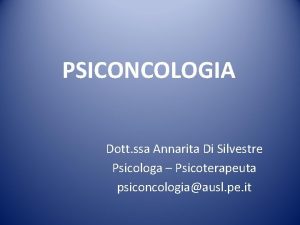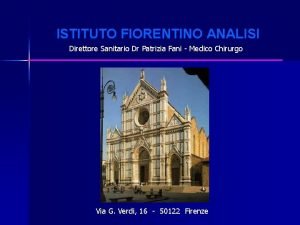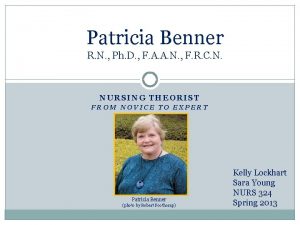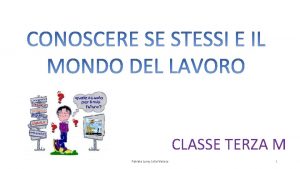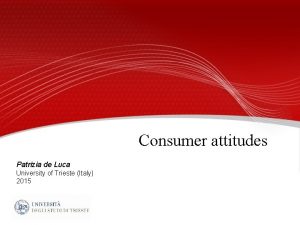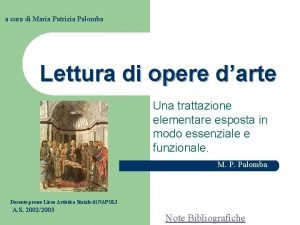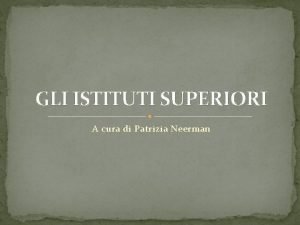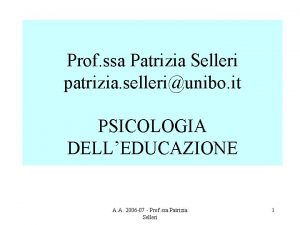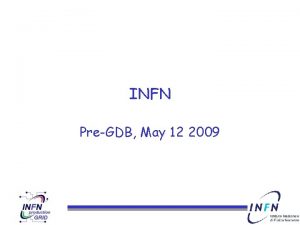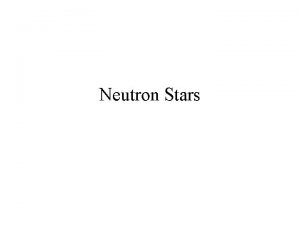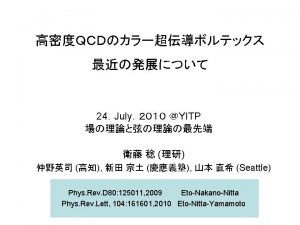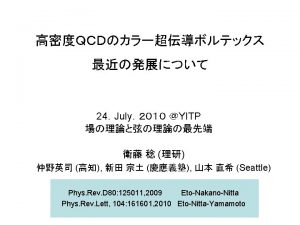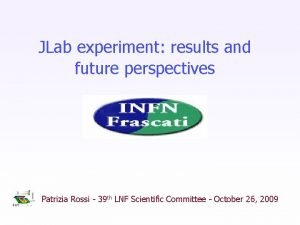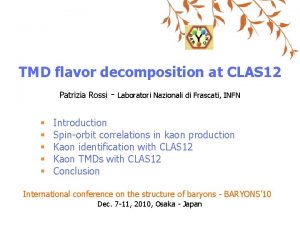Neutron Detector INFN plans Patrizia Rossi for the










- Slides: 10

Neutron Detector: INFN plans Patrizia Rossi for the INFN groups: Genova, Laboratori Nazionali di Frascati, Roma Tor Vergata Tracker q q Simulations Timing Tests Tracker CLAS 12 Central Detector Meeting - Saclay 2 -3 December 2009

Detector Simulations A Spaghetti Calorimeter option has been extensively studied by the INFN group with Monte Carlo simulations in order to determine: • • • Neutron detection efficiency TOF resolution (for n- separation in the momentum range of interest) Angular resolution (for the definition of the neutron direction) Simulation done with FLUKA (KLOE) Parallelepiped shape (12. 15 x 60 x 9. 6) cm Beam to the longer side, and to fibers 20 cells (5 x 4), each 2. 43 x 2. 4 cm (x, z) each cell contains 360 fibers LEAD FIBERS y Compared to Scintillator Barrel : Neutron Efficiency: spaghetti calorimeter ~30 -40% more efficient Angular resolution: the two options give comparable results TOF resolution: the two options give comparable results But spaghetti calorimeter: 1) Too efficient for 2) Energy loss localized in few fibers 1. limitation for signal read-out x d=1 mm 12. 15 cm 1) 2) 3) 60 cm beam Option discarded 6 9. cm z

Background Simulations_1 Simulation of the background were done with gemc 1 event @ L=1033 cm-2 s-1 ELECTROMAGNETIC BACKGROUND We want to understand: • the actual rates seen by the CND, their energy distribution etc. • the probability of such background to be reconstructed as a “good neutron” event Results: • The background consists of photons • The overall rate is � 2 GHz at luminosity of 1035 • The maximum rate on a single paddle is 22 MHz (1. 5 for Edep>100 Ke. V) • This background can be reconstructed as a neutron: - using a 5 Me. V energy threshold the resulting rate is few KHz - the of this “fake”neutrons is <0. 1 -0. 2 - the actual contamination depends on the hadronic rate in the forward part of CLAS 12 (@ 1 KHz the rate of fake events is 0. 4 Hz) We can handle it 0 0, 2 0, 4 0, 5 0, 6 0, 7 0, 8

Background Simulations_2 PHYSICS BACKGROUND First estimate of hadronic background based on clas. DIS event generator (pythia) All event rate Background events that could mimic a DVCS event are defined as: § Q 2>1 Ge. V 2 § W>2 Ge. V § one energetic photon (E >1 Ge. V) in forward direction § one photon in the central detector § MM(e ) < 1. 1 Ge. V Estimated rate at full luminosity (1035 cm-2 s-1) ~ 5 Hz (with one photon in CD) We need to finalize n. DVCS event generator to estimate neutron rates eg missing mass

Timing Tests § TOF resolution required to separate from n for neutron momentums up 1 Ge. V/c ~100 -120 ps § Constraints on photodetectors: - Light collection in high magnetic field - Limited space for signal read-out No space for light guides due to the presence of the CTOF light guides Timing tests wil be performed in 2010 by the INFN groups using different setup

Timing Tests Scintillator type Readout BC-408 PMT H 2431 -50 BC-408 • Si. PM 1 x 1 mm 2/ 3 x 3 mm 2/matrix 12 Fermilab estruded scintillators +1 WLS • Si. PM 1 x 1 mm 2/ 3 x 3 mm 2/matrix 12 Fermilab estruded scintillators > 1 WLS • Si. PM 1 x 1 mm 2/ 3 x 3 mm 2/matrix 12 q q q BC-408: =380 cm ; decay constant=2. 1 ns PMT H 2431 -50: rise time = 0. 7 ns; transit time spread = 0. 37 ns Acquisition: Full electronic chain discriminator+TDC Electronics, redout, scintillators in Genova

Estruded scintillator + WLS

Redout

Timing Tests Cosmic ray PMT 1 PMT 2 X 1 PMT 3 Si. PM Fermilab estruded scintillator PMT 4 Si. PM X 3 PMT 5 PMT 6 X 5 t 1=t 0+x/v+c 1 t 2=t 0+(L-x)/v+c 2 (t 1 -t 2)=(2 x 1 -L)/v+c 1 -c 2 (t 3 -t 4)=(2 x 3 -L)/v+c 3 -c 4 (t 5 -t 6)=(2 x 5 -L)/v+c 5 -c 6 (t 1+t 2)=2*t 01+L/v+c 1+c 2 (t 3+t 4)=2*t 03+L/v+c 3+c 4 (t 5+t 6)=2*t 05+L/v+c 5+c 6 taking into account that: (x 1+x 5)=2*x 3 or (t 01+t 05)=2*t 03 (t 1 -t 2)+(t 5 -t 6)-2(t 3 -t 4)=costant (t 1+t 2)+(t 5+t 6)-2(t 3+t 4)=costante Spread of these quantities is a measurement of the timing resolution

Conclusions q q q INFN groups of Genova, Laboratori di Frascati, Roma Tor Vergata are involved in the development of the central neutron detector Simulations have been done to determine its characteristics (neutron detection efficiency, angular resolution, timing resolution. . ) as well as the e. m. and physics background Timing tests are planned for 2010 using different scintillators and redout systems
